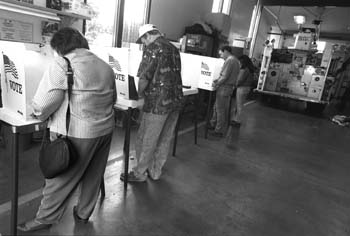Big Buck Trends
Curtain Call: Residents of the valley's wealthier neighborhoods out-voted the less-fortunate last Tuesday, perhaps because candidates targeted their campaigns toward the voting class.
Candidates in Silicon Valley tailor their messages and their strategies to the folks who live in the nicer neighborhoods, and those are the people who turn out at the polls. Which is the chicken and which is the egg?
By Cecily Barnes
FORMER STATE TREASURER Jess Unruh once said, "Money is the mother's milk of politics." The results of the June 2 primary election in the Santa Clara Valley show that money doesn't seem to hurt voter turnout either. Local political analysts weren't too surprised to find statistics from the county Registrar of Voters showing that the valley's four wealthiest cities produced the biggest pile of ballots.
Monte Sereno, where the average household income is $198,000, took first place: 68 percent of the registered voters in that bucolic berg punched ballots. Voters in Los Altos, Los Altos Hills and Saratoga--where family units earn between $151,600 and $260,400--also turned out in surprisingly large numbers.
On the flip side, ballot counts paled in the three valley cities with the lowest household incomes: Gilroy, Campbell and Santa Clara.
These statistics demonstrate the sad fact that more often than not, poor people don't vote.
Kim Alexander, president of the California Voter Foundation, offers some suggestions as to why this trend continues. "Look at the complexity of the California ballot," Alexander says. "You practically have to have a Ph.D. to vote." Rich people, she says, are generally better educated and can more easily decipher the complex modern ballot.
Poor people also rent instead of own homes, Alexander says, and since renters move frequently, they outrun campaign tracking radar that would remind them of upcoming elections. Availability of free time factors in as well, she says: It is simply easier for the corporate executive to cut out for a few hours on election day than it is for a McDonald's worker.
Graph showing relationship of household income to voter turnout.
Paul Hendrie from the Center for Responsive Politics, a nonprofit group in Washington, D.C., that tracks voter trends, says the problem could be solved if politicians would only pay attention to the poor voter. Instead, he says, it's a self-perpetuating cycle. Politicians don't court poor people because poor people don't vote. And poor people don't vote because politicians don't pay attention to them.
"Once you get people feeling like they're being paid attention to in a campaign, they want to vote," Hendrie says.
These factors can be seen at play in the San Jose mayoral race, says Greg Seller, CEO of the political consulting group Strategy Source.
"In a campaign of any size the first thing you look for is who votes," Sellers says. "And then you focus on those places more likely to vote. It's a basic economic decision: You go where you get more bang for your buck."
Although mayoral candidates Gonzales, Dando and Napoli dutifully spent an evening repeating their campaign promises to homeless people at the Emergency Housing Consortium, it was a meager effort compared to the attention showered on wealthy districts like Willow Glen, where Gonzales set up campaign headquarters and went knocking door to door.
"I'm sure locating in Willow Glen wasn't just an arbitrary decision," Sellers says, adding that candidates have to spend their limited money in areas they know will be responsive.
"Maybe Pat Dando would have been interested in spending money on the East Side, but the money she would have had to spend would be excessive and probably not be worth the benefit she would receive."
[ San Jose | Metroactive Central | Archives ]
![]()

Christopher Gardner

From the June 11-17, 1998 issue of Metro.
![[Metroactive News&Issues]](/gifs/news468.gif)